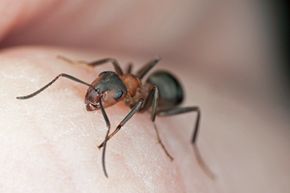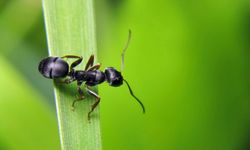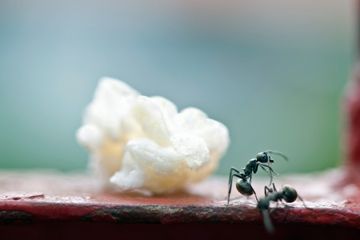Fire ants are aggressive insects that can inflict bites and venomous stings when they feel threatened. If you've been bitten, you know the experience is no laughing matter. Fire ant bites are painful, and their stings burn, itch and cause bumps or small blisters that can leave scars. An allergic reaction to a fire ant sting has the potential to be life threatening, too. Although fire ants are related to bees and wasps, fire ant venom is different, and instead of stinging once like a honey bee, a fire ant can sting a victim multiple times in a distinctive circular pattern.
If you unwittingly disturb a fire ant mound, or even walk within a few feet of one, the vibrations from your movements can trigger a swarming defense response from the ants. This can lead to multiple stings from numerous ants. Where many insect species flee or hide when threatened or disturbed, fire ants attack, even when they're away from the nest foraging in small numbers. This makes them particularly dangerous. The bad news is that fire ant populations are spreading. They can now be found throughout the Southeastern United States as well as in portions of California, Arizona and New Mexico. The good news is that most fire ant stings can be treated without a visit to the doctor:
Advertisement
- Don't try to wash ants off -- Fire ants don't just sting, they bite and cling to the skin. Trying to remove multiple ants with a blast of water from a garden hose doesn't work as well as brushing them off with a firm, rubbing motion using a cloth or towel.
- Clean the area -- Wash the area thoroughly with soap and warm water.
- Stop the discomfort -- Over-the-counter medications containing oral antihistamines or topical corticosteroids designed to reduce the discomfort of insect bites may help, but so will home remedies like applying a cold compress.
- Don't scratch -- Fire ant venom kills healthy cells at the injection site, and the body responds by forming a small, protective blister or pustule that itches and is tender to the touch. Don't scratch. Breaking the pustules makes fire ant bites more vulnerable to infection. Pustules form as a result of the introduction of ant venom. If the ants are removed after they bite but before they sting, there may be some discomfort and redness, but pustules won't form.
- Watch for allergic reactions -- Extreme allergic reactions to fire ant stings affect only about 1 percent of the population. Children and the elderly are at the greatest risk. It's still important to observe stinging victims and get help immediately if they exhibit any of the following symptoms: chest pain, excessive sweating, nausea, extreme swelling of the affected area, tongue swelling, slurred speech or trouble breathing.



